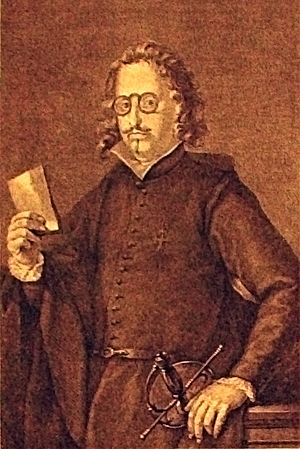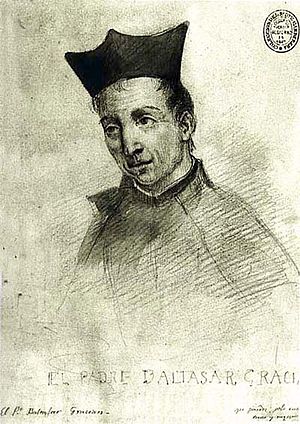Conceptismo facts for kids
Conceptismo (say "kon-sep-TEEZ-moh") was a clever way of writing that became popular in Spain during the Baroque period. This was from the late 1500s through the 1600s, a time known as the Spanish Golden Age.

Conceptismo writing used a fast rhythm and simple words. It was known for witty comparisons (metaphors) and wordplay. Writers tried to pack many meanings into just a few words. They focused on smart ideas rather than fancy vocabulary.
What is Conceptismo?
A main thinker behind conceptismo was Baltasar Gracián. He wrote a book called Agudeza y arte de ingenio. In it, he said a "concept" is like a smart thought that shows how different things are connected.
Conceptismo aimed for very short expressions with the biggest possible meaning. Writers wanted to use as few words as they could. They often suggested many meanings, as long as they fit the main idea of the work.
Writers used clever word tricks to achieve this. They played with the meanings of words and how they related to each other. Some common tricks included:
- Leaving out words that the reader could guess (ellipsis).
- Using one word to connect two different ideas (zeugma).
- Phrases that could mean two things (amphibology).
- Words with multiple meanings (polysemy).
- Putting opposite ideas together (antithesis).
- Using words that sound the same but have different meanings (puns).
Like other Baroque styles, conceptismo valued language that made you think. Gracián believed that "Truth, when it is more difficult, is more pleasant." He also thought that "knowledge that costs is more valued." This meant that understanding something challenging felt more rewarding.
The most famous writer of Spanish conceptismo was Francisco de Quevedo. He wrote with a lot of irony and sharp humor. Baltasar Gracián also used this style.
Conceptismo vs. Culteranismo
Conceptismo was very different from culteranismo. Culteranismo was another writing style from the Baroque period. It used very showy words and complicated sentence structures. It also had many complex comparisons (metaphors). However, its ideas were often quite ordinary.
To put it simply:
- Conceptismo used few words but packed them with deep meaning.
- Culteranismo used many fancy words but with less direct meaning.
Both styles believed that language should be a bit challenging. They thought this made the writing more valuable.
Don't think conceptismo was simpler just because it used easier words. It hid its complexity using many clever techniques. Likewise, culteranismo was not less meaningful. It just showed its meaning through its elaborate language, rather than through hidden ideas.
The most famous culteranismo writer was Luis de Góngora. He had a famous rivalry with Francisco de Quevedo. They often criticized each other's writing and personal lives.
See also
 In Spanish: Conceptismo para niños
In Spanish: Conceptismo para niños


